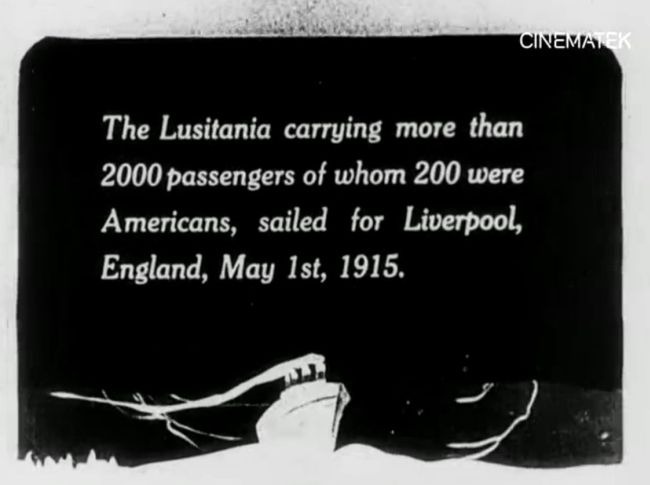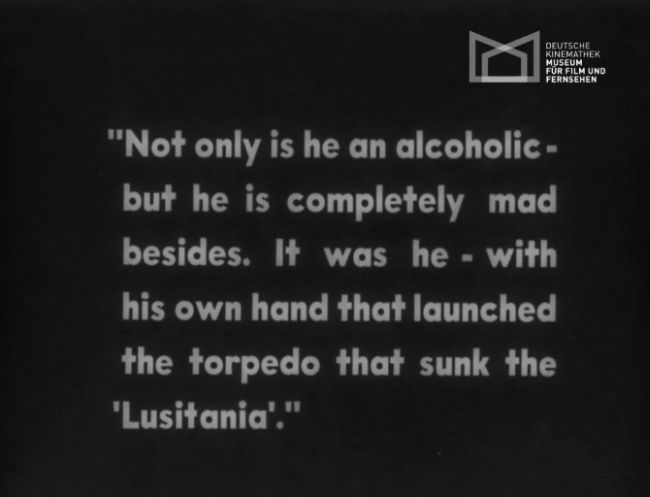How films reported the martime disaster of the Lusitania
Ninety-nine years ago, RMS Lusitania, a British ocean liner, was sunk by a German U-Boat, resulting in the deaths of 1,198 passengers and crew and eventually leading to America’s entry into World War I.
In early 1915 German submarines, or 'U-Boats', began to be used in the German maritime campaign against the British.
Initially they were used only to attack naval ships but soon began to attack merchant vessels, though usually in accordance with the Cruiser Rules which stated that 'a warship … may not sink or render incapable of navigation a merchant vessel without having first placed passengers, crew and ship's papers in a place of safety'.
However, even with these rules in place it was clear that ships which sailed in the seas around the British isles were at risk of being attacked by German submarines.
The German embassy in Washington D.C. even placed a warning advertisement in American newspapers telling passengers travelling to Great Britain that they did so at their own risk. Some passengers were concerned about this warning, but on the whole it was not considered to be a serious threat by the majority of the passengers, and survivors of the disaster have said that the threat of being attacked was taken light-heartedly and was even the subject of jokes on board the ship.
On 7 May 1915, Lusitania had almost reached its destination of Liverpool when she crossed in front of the German submarine U-20, captained by Kapitänleutnant Walther Schwieger. Schwieger gave the command to fire a torpedo which struck Lusitania on the starboard side. A second explosion occurred moments later which rocked the boat further, and caused the ship to tilt to one side. This meant that the lifeboats on one side of the boat were completely unusable, and as a result only six lifeboats were successfully launched.
Some passengers jumped overboard and clung onto rafts, while others were offered refuge when the collapsible lifeboats floated out of the sinking ship.
After only 18 minutes, the Lusitania had completely sunk.
Of the 1,961 verified passengers aboard the ship, only 764 survived, of whom 128 were American. The sinking caused an international uproar, both in Britain and in America, and this loss of neutral American citizens is widely considered to be one of the reasons that America joined the war in 1917.
There is no actual footage of the sinking of the ship but re-enactments where shot after the tragic event. Examples of these, usually propagandistic productions, can be found on the EFG1914 website, where films and other non-film material relating to World War I have been digitised and made available by 21 European film archives.
The 1918 film, The Sinking of the Lusitania, from the archives of the Cinémathèque Royale de Belgique, was made by American animator Winsor McCay in the style of a documentary. It aimed to inspire an anti-German sentiment by describing the incident as 'the most violent cruelty that was ever perpetrated upon an unsuspecting and innocent people' and as 'the crime that shocked humanity'.
The Sinking of the Lusitania, 1918. European Film Gateway
Similarly, Lest We Forget, a 1918 British film from the Imperial War Museum’s archive, stresses the fact that the ship was unarmed and refers to the Germans as Huns who must be stopped. The film also shows an excerpt which appears to be from a German newspaper and reads, 'With joyful pride we contemplate this latest deed of our navy'. Here the British are not only condemning the German navy for sinking the ship but portraying the whole nation as cruel and merciless enemies.
Lest We Forget, 1918. European Film Gateway
Interestingly, however, there is an American film in the collection from the Deutsche Kinemathek which portrays 'the German' quite differently.
In The False Faces, released at some time between 1918-1919, one of the characters is supposed to be the captain of the German U-Boat which fired the torpedo at RMS Lusitania. He is seen to be having visions of those who perished on the ship and in the surrounding waters and seems to be driven mad with sorrow and shame for what he did.
The False Faces, 1918/1919. European Film Gateway
Even after almost a hundred years, the sinking of the Lusitania is considered a controversial international event and there are many theories surrounding it which reject the British Admiralty’s official version of events.
It is widely accepted that there were two explosions on RMS Lusitania, based on Walther Schwieger’s eyewitness account as well as countless others from survivors who managed to escape from the ship onto the lifeboats. This, coupled with the fact that the ship took a mere 18 minutes to sink, has led historians to suggest that the ship was carrying military ammunition which created an explosion, which would have meant that the ship was in violation of the Cruiser Rules and therefore that Schwieger’s decision to fire at it was legitimate.
However, even to this day the British government have still never confirmed the presence of ammunition on the ship, despite 4 million American-made bullets having been found in and around the shipwreck by divers in 2008, and instead still consider that the German U Boats violated maritime law by firing a torpedo at a passenger cruiser.
It has also been suggested that the Lusitania was sunk on purpose by the British Admiralty in order to enrage the Americans and encourage them to join the war against the Germans. Whether this was the case or not, the sinking of RMS Lusitania did act as a very effective propaganda tool against the Germans in both America and Great Britain.




